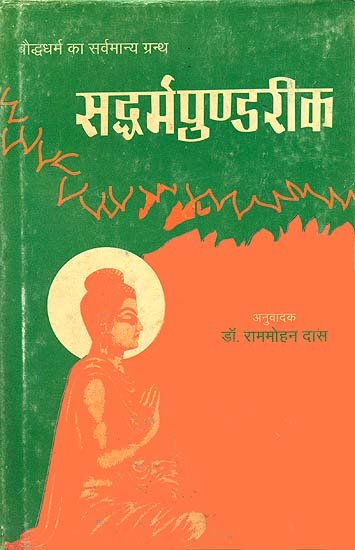Lotus Sutra (Saddharma-Pundarika) [sanskrit]
by H. Kern | 2013 | 16,351 words | ISBN-13: 9788120801226
The Lotus Sutra (Saddharma-pundarika) is an important Mahayana Buddhist scripture classified as one of the nine Dharmas. the Lotus Sutra deals with a wide range of important Buddhist teachings in twenty-seven chapters including the nature of the Buddhas and the inherent potentiality of becoming Buddha within all beings. This editions only contains the Sanskrit metrical text and the corresponding English translation. Alternative titles: Saddharma-puṇḍarīka-sūtra (सद्धर्म-पुण्डरीक-सूत्र).
Verse 3.5
द्वात्रिंशती लक्षण मह्य भ्रष्टा सुवर्णवर्णच्छविता च भ्रष्टा ।
बला विमोक्षाश्चिमि सर्वि रिञ्चिता तुल्येषु धर्मेषु अहो ऽस्मि मूढः ॥ ५ ॥
dvātriṃśatī lakṣaṇa mahya bhraṣṭā suvarṇavarṇacchavitā ca bhraṣṭā |
balā vimokṣāścimi sarvi riñcitā tulyeṣu dharmeṣu aho 'smi mūḍhaḥ || 5 ||
The thirty-two characteristic signs have failed me, and the gold colour of the skin has vanished; all the (ten) powers and emancipations have likewise been lost. O how have I gone astray at the equal laws!
English translation by H. Kern (2013) Buy now!
Glossary of Sanskrit terms
Note: This extracts Sanskrit terms and links to English definitions from the glossary, based on an experimental segmentation of verse (3.5). Some terms could be superfluous while some might not be mentioned. Click on the word to show English definitions.
Dvatrimshati, Lakshana, Mahya, Bhrashta, Suvarnavarna, Ccha, Bala, Vimoksha, Tulya, Dharma, Dharmeshu, Ahan, Ahu, Mudha,
Analysis of Sanskrit grammar
Note: this is an experimental feature and only shows the first possible analysis of the Sanskrit text (Lotus Sutra Verse 3.5). If the system was successful in segmenting the sentence, you will see of which words it is made up of, generally consisting of Nouns, Pronouns, Verbs, Participles and Indeclinables. Click on the link to show all possible derivations of the word.
- Line 1: “dvātriṃśatī lakṣaṇa mahya bhraṣṭā suvarṇavarṇacchavitā ca bhraṣṭā ”
- dvātriṃśatī -
-
dvātriṃśati (noun, feminine)[nominative dual], [vocative dual], [accusative dual]
- lakṣaṇa -
-
lakṣaṇa (noun, masculine)[compound], [vocative single]lakṣaṇa (noun, neuter)[compound], [vocative single]
- mahya -
-
mahya (noun, masculine)[compound], [vocative single]mahya (noun, neuter)[compound], [vocative single]√mah -> mahya (participle, masculine)[compound from √mah]√mah -> mahya (participle, neuter)[compound from √mah]√mah -> mahya (absolutive)[absolutive from √mah]√mah -> mahya (absolutive)[absolutive from √mah]√mah -> mahya (participle, masculine)[vocative single from √mah class 10 verb], [vocative single from √mah]√mah -> mahya (participle, neuter)[vocative single from √mah class 10 verb], [vocative single from √mah]
- bhraṣṭā -
-
bhraṣṭā (noun, feminine)[nominative single]√bhṛjj (verb class 6)[periphrastic-future active third single]
- suvarṇavarṇa -
-
suvarṇavarṇa (noun, masculine)[compound], [vocative single]suvarṇavarṇa (noun, neuter)[compound], [vocative single]
- ccha -
-
ccha (noun, masculine)[compound], [vocative single]ccha (noun, neuter)[compound], [vocative single]
- vitā -
-
- ca -
-
ca (indeclinable conjunction)[indeclinable conjunction]ca (noun, masculine)[compound], [vocative single]ca (noun, neuter)[compound], [vocative single]
- bhraṣṭā -
-
bhraṣṭā (noun, feminine)[nominative single]√bhṛjj (verb class 6)[periphrastic-future active third single]
- Line 2: “balā vimokṣāścimi sarvi riñcitā tulyeṣu dharmeṣu aho 'smi mūḍhaḥ ”
- balā* -
-
bala (noun, masculine)[nominative plural], [vocative plural]balā (noun, feminine)[nominative plural], [vocative plural], [accusative plural]
- vimokṣāś -
-
vimokṣa (noun, masculine)[nominative plural], [vocative plural]vimokṣā (noun, feminine)[nominative plural], [vocative plural], [accusative plural]
- cimi -
-
cimi (noun, masculine)[compound], [adverb]
- sarvi -
-
- Cannot analyse riñcitā*tu
- tulyeṣu -
-
tulya (noun, masculine)[locative plural]tulya (noun, neuter)[locative plural]√tul -> tulya (participle, masculine)[locative plural from √tul class 10 verb]√tul -> tulya (participle, neuter)[locative plural from √tul class 10 verb]
- dharmeṣu -
-
dharmeṣu (noun, masculine)[compound], [adverb]dharmeṣu (noun, feminine)[compound], [adverb]dharmeṣu (noun, neuter)[compound], [adverb], [nominative single], [vocative single], [accusative single]dharma (noun, masculine)[locative plural]
- aho' -
-
ahan (noun, neuter)[compound], [adverb], [nominative single], [vocative single], [accusative single]ahar (noun, neuter)[adverb]ahu (noun, masculine)[vocative single]ahu (noun, feminine)[vocative single]√has (verb class 1)[aorist active second single]
- asmi -
-
√as (verb class 2)[present active first single]
- mūḍhaḥ -
-
mūḍha (noun, masculine)[nominative single]√muh -> mūḍha (participle, masculine)[nominative single from √muh class 4 verb]
Other editions:
Also see the following editions of the Sanskrit text or (alternative) English translations of the Lotus Sutra Verse 3.5
The Lotus Sutra (The Saddharma-Pundarika)
by H. Kern (2013)
The Lotus Sutra (Text with Hindi Translation)
by Ram Mohan Das (2001)
![Lotus Sutra (Saddharma-Pundarika) [sanskrit] - book cover](/uploads/a/Lotus-Sutra.jpg)
